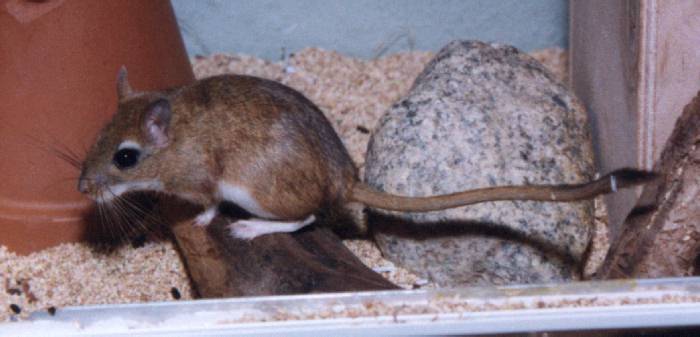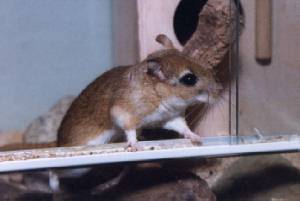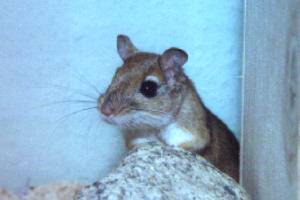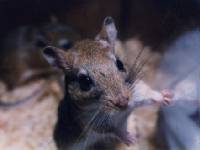This article originally appeared in the December 1998 issue
of the NGS Journal.

On our last trip to Holland we were fortunate enough to be able to bring back
a small number of Persian Jirds (Meriones persicus). These are a truly beautiful
gerbil, very inquisitive and quite tame. I am sure they will soon become sought
after as a pet, for the same reasons that Shaw’s Jirds
(M shawi) are so popular.
The Persian Jird is large. Although not as well built as a Shaw’s Jird, it
is a little longer, about 6" (155mm), with a tail that is about 15% longer
than the body. Their coloration is the normal agouti colour that anyone familiar
with gerbils or jirds will know well. The belly is a particularly brilliant
white. The long tail has a beautiful brush that extends along nearly a third of
its length.
They come from many parts of central Asia including Turkey, Iran,
Afghanistan, and many parts of ex-Soviet central Asia such as Turkmenistan and
Azerbaidjan. In some regions they occupy flat semi-deserts, but their favourite
habitat is dry rocky hillsides with little vegetation. They prefer sloping
ground and will occupy the rock strewn mountain gorges cut by seasonal streams
and rivers. Although they will dig burrows, these are fairly simple affairs by
gerbil standards and have few entrances. They can be up to 5’ 6" (175cm)
but are often less. The burrows have a few chambers, mainly for sleeping and
storing food. Instead of burrows, Persian Jirds will often simply shelter under
overhanging rocks. The burrows are usually well spaced out. Like many of the
larger Meriones species they live in loose communities rather than the close
knit colonies that the more familiar Mongolian Gerbil creates.
Persian Jirds are not shy of taking advantage of human habitation. They often
live under walls, on the banks of irrigation ditches and the margins of areas of
cultivation. They will take advantage of ruined buildings as a place of shelter.
In the wild their diet mainly consists of dry plant material and cereals. But
they are particularly partial to fresh vegetables. They are known to also eat
insects and small animals. Although nocturnal, Persian Jirds are active during
the day. Like Mongolian Gerbils they will quickly wake to investigate any
disturbance.


In the regions where they live the climate is dry, with between 8 and 12
inches (200-300mm) of rain a year, with the majority falling in spring. The
temperature can vary a lot also. The very clear skies mean that summer mean
daytime temperatures are about 25C but winter temperatures can fall well below
freezing. As Persian Jirds can live at fairly high altitudes, 6000 feet (2000m)
or more, temperatures in winter at night must get very low.
Persian Jirds normally have two litters a year, one in the Spring, and one in
Autumn. In some regions like Azerbaidjan they have a third litter in Winter. The
average size of litters is seven. The gestation period of Persian jirds is about
28 days.
In captivity litters are normally produced between May and September, a
mother will make a nest for her litter and will keep other Jirds away. They do a
good job of caring for their pups and normally all survive. Being large animals
they need a lot of space. They will not even breed unless they have five square
feet of space (half a square metre). In such a tank you can keep a male and two
females. The females will make separate nests and both will usually breed
successfully. Persian Jirds rarely if ever fight, but a female jird will
aggressively defend her litter from other jirds.
In captivity they have been known to live for six or seven years.
They love to climb and jump. They are very agile. One of the reasons they
need space is that they do not jump upwards, but leap from rock to rock etc.
They like to have a nest box, but give them several as they may fill the first
one up with hoarded food! In captivity it is fairly easy to reproduce their
natural diet with normal hamster mix, mealworms and/or dry cat food.
They are naturally quite tame animals. They do not bite, seem unafraid of
humans and can be handled quite easily. Hopefully ours will breed next year and
they can join Shaw’s Jirds as a popular if unusual gerbil.
References:
The Natural Regions of the USSR, Berg L.S., Mackmillan, 1950
Rodents in Desert Environments, Prakash, L. and Gosh, P.K. (volume editors),
Monographiae Biologicae Vol 28, Dr W. Junk b.v. Publishers, The Hague, 1975,
ISBN 90 6193 080 4
Karin van
Veen’s Gerbil Information Page


The last image is available as a Gerbil
Wallpaper!




























Return to the NGS Homepage?
The views presented on this page are not necessarily those of the National
Gerbil Society.
Please note that the material on these webpages is covered by copyright law.
If you wish to use any pictures etc for anything other than your personal
private use, such as publishing material on a website, then
This web page may include links to other web sites. These links are provided
in order to enhance the interest and usefulness of other content and are not
intended to signify that the National Gerbil Society, or the authors of material
featured on the NGS Website, endorses or otherwise has any responsibility for
the content of any linked web page, web site or other linked material.
This page has been constructed by
Telephone number for media contact only - (+44)
07941893143
Last updated 22 September 2007




